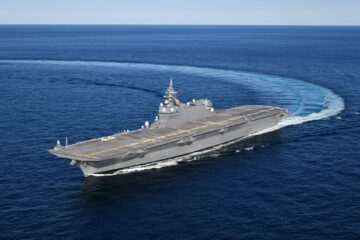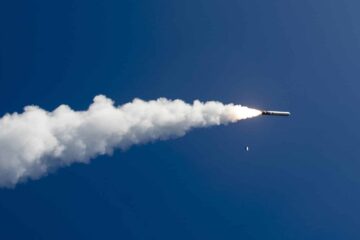U.S. Navy press release
Keen Sword 23 was designed to enhance Japan-U.S. readiness and interoperability while strengthening the bilateral relationship and demonstrating U.S. resolve to support the security interests of Allies and partners in the region. Keen Sword does so by providing militaries opportunities to train across a variety of mission areas in realistic scenarios, enhancing readiness, interoperability, and building credible deterrence.
Participating Navy units included the embarked staffs of CSG 5, Carrier Air Wing Five (CVW 5), and Destroyer Squadron (DESRON) 15 along with the aircraft carrier USS Ronald Reagan (CVN 76), guided-missile cruiser USS Chancellorsville (CG 62), and guided-missile destroyer USS Benfold (DDG 65).

U.S. Navy and Japan Maritime Self-Defense Force (JMSDF) worked together on several anti-submarine warfare (ASW) and surface gunnery events designed to advance joint tactics between the Pacific partners.
“As Allies working together we demonstrate our collective resolve in facing shared maritime challenges. While this exercise has benefitted us tactically and professionally, it also is a powerful symbol of the strength of a force all committed to the same ideals that keep this region secure and stable.”
Rear Adm. Michael Donnelly, Commander of CSG 5, Task Force (CTF) 70
During KS23, Vice Adm. YUASA Hideki, Commander-In-Chief Japan Self-Defense Fleet, along with Vice Adm. Karl Thomas, Commander, U.S. 7th Fleet, visited the U.S. Navy’s only-forward deployed aircraft carrier, USS Ronald Reagan (CVN 76), as well as JS Izumo (DDH 183). Throughout the exercise, liaison officers from Japan and the Royal Australian Navy were integrated into the operations of the strike group.
“I appreciate that we had the occasion to work with all members of CSG 5 on USS Ronald Reagan, and we received knowledge and lessons learned with their support through Keen Sword 23. This exercise contributed to improving the tactical and operational capabilities of the JMSDF, and enhanced the effectiveness of bilateral operations between Japan and the U.S. We are facing big challenges in the region, but our relationship is stronger than at any time in history, and is contributing to the strengthening deterrence and response capabilities of the alliance, and to the peace and stability of the Indo-Pacific region.”
Rear Adm. HIRATA Toshiyuki, Commander of Escort Flotilla Four, JMSDF
This year, for the first time ever, the JMSDF embedded an Information Warfare Commander (IWC) and planning staff into CTF 70 IW team where they made great progress in areas such as information sharing, electronic warfare, and expanding collective warfighting capabilities. This afloat opportunity built upon the success of several routine exercises and exchanges held in Yokosuka over the past 18 months.

“Having the JMSDF IWC and his team of experts onboard USS Ronald Reagan working alongside our team has been a tremendous success,” said Capt. Kurt Mole, CSG 5 IWC. “We learned so much from each other and were able to leverage the strengths of each team. This was a significant advancement of our IW collaboration and I’m excited to continue moving the relationship forward.”
On Nov. 14, formation sailing took place with one submarine from the JMSDF and 19 ships from the U.S. Navy, JMSDF, United Kingdom (Royal Navy), Royal Australian Navy (RAN) and Royal Canadian Navy (RCN).
“We have stood side-by-side and we are aligned to stand together in the future,” said Capt. David Tietzel, Commander, Australian Maritime Task Group (COMAUSMARTG). “Our teams that worked on USS Chancellorsville and USS Ronald Reagan have brought back valuable lessons learned. We want to continue being the link across different domains bringing our warships and people together.”
The Japan Ground Self-Defense Force (JGSDF) and U.S. Marine Corps conducted multiple side-by-side amphibious landings on Japanese islands to demonstrate the capability of forward-deployed forces to swiftly counter aggression against regional Allies and partners.
JSDF and U.S. forces have conducted the joint/bilateral field training exercise Keen Sword since 1986 designed to increase combat readiness and interoperability.
USS Ronald Reagan Carrier Strike Group is underway conducting operations in support of a free and open Indo-Pacific. U.S. 7th Fleet conducts forward-deployed naval operations in support of U.S. national interests in the Indo-Pacific area of operations. As the U.S. Navy’s largest numbered fleet, 7th Fleet interacts with 35 other maritime nations to build partnerships that foster maritime security, promote stability, and prevent conflict.






